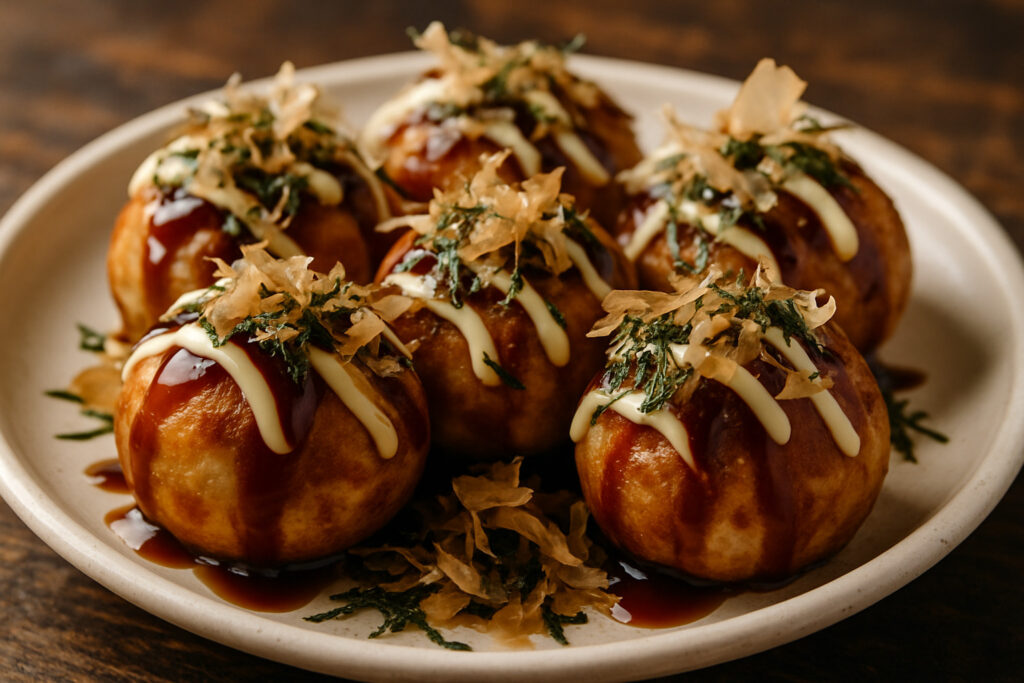Why Takoyaki is Japan’s Most Addictive Street Food
Takoyaki are crispy-outside, gooey-inside octopus balls that originated in Osaka, Japan in 1935. These golf ball-sized snacks are made from wheat flour batter cooked in special round molds, filled with diced octopus, and topped with savory sauce, mayo, seaweed flakes, and dancing bonito flakes.
Quick Takoyaki Facts:
- What it is: Round Japanese street snack with octopus inside
- Origin: Osaka, 1935, invented by Tomekichi Endo
- Taste: Crispy exterior, creamy interior, umami-rich flavor
- Typical serving: 6-8 balls per order
- Cooking time: About 15 minutes in specialized pan
- Calories: ~159 per 4-ball serving
Picture this: you’re walking through a busy Japanese festival when the smell of grilled batter and smoky bonito flakes hits you. Steam rises from a cast-iron pan dotted with perfect golden spheres. The vendor flips each ball with lightning speed using bamboo picks, creating a mesmerizing dance of sizzling street food.
That’s the magic of takoyaki – Japan’s beloved octopus balls that have captured food lovers worldwide. Originally sold from yatai (mobile food stalls) during summer festivals, these bite-sized treasures represent everything great about Japanese street food culture.
What makes takoyaki so special? It’s the perfect contrast of textures and flavors. The crispy, golden exterior gives way to a molten, savory center packed with tender octopus chunks, pickled ginger, and tempura scraps. Each bite delivers waves of umami from the dashi-infused batter and toppings.
Whether you’re planning a trip to Osaka or want to recreate this iconic snack at home, understanding takoyaki opens the door to Japan’s rich konamon (flour-based) food culture.
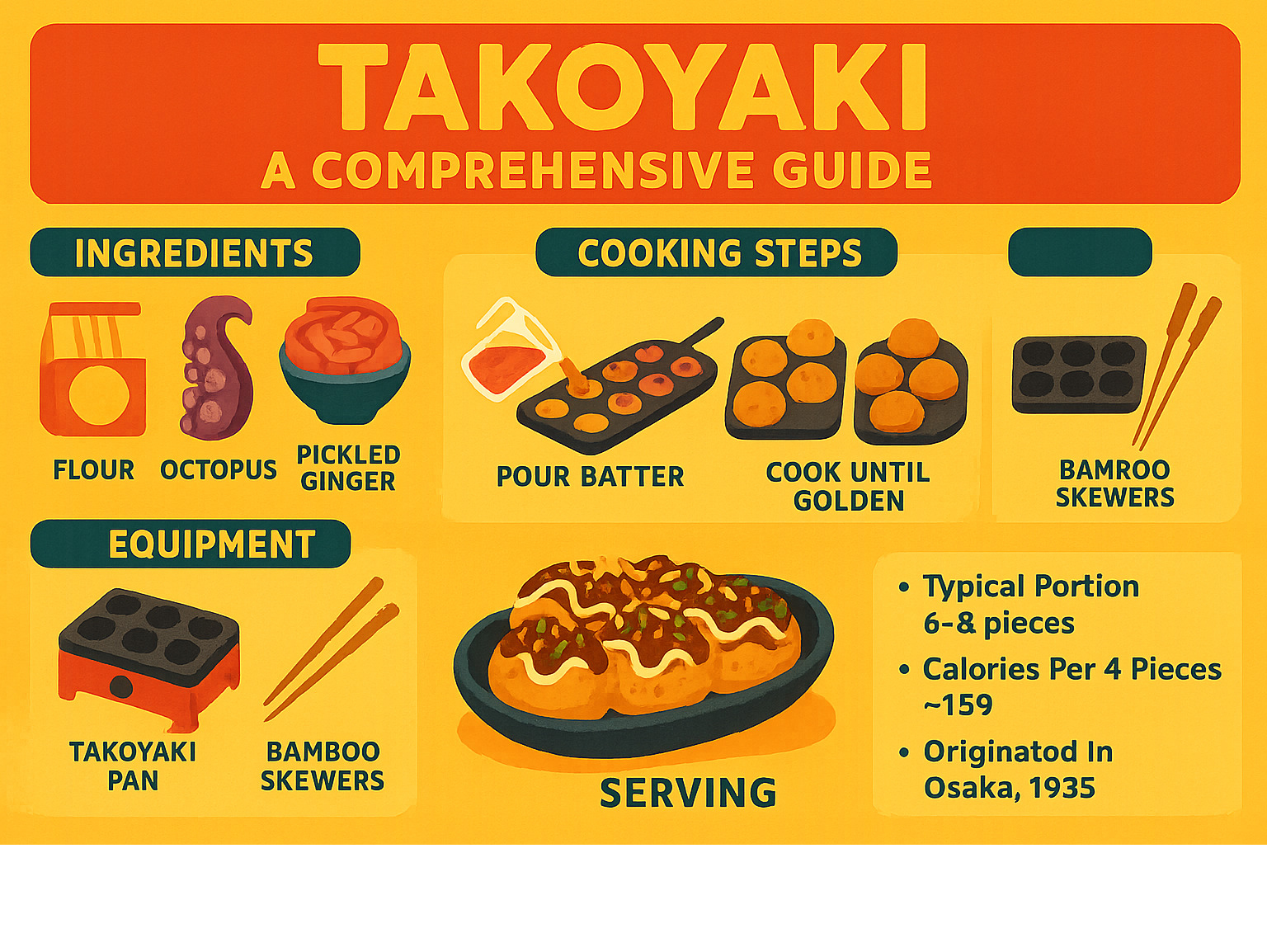
Must-know takoyaki terms:
Takoyaki: Origins, History & Culture
Picture Osaka in 1935 – a busy merchant city where street vendors competed for customers with creative twists on familiar flavors. That’s when Tomekichi Endo made culinary history by combining the soft, egg-rich akashiyaki from nearby Akashi with local street snacks like choboyaki and radioyaki. His genius? Adding chunks of tender octopus and creating what we now know as takoyaki.
Endo’s creation wasn’t just another snack – it perfectly captured Osaka’s spirit. The city was already famous for its konamon culture (flour-based dishes like okonomiyaki), and takoyaki became the crown jewel of this tradition. The theatrical cooking style, with vendors flipping dozens of balls simultaneously using bamboo picks, turned food preparation into entertainment.
After World War II, takoyaki spread beyond Osaka’s borders like wildfire. Festival yatai (mobile food stalls) carried these golden spheres to summer matsuri across Japan. What started as a local specialty became a national obsession, then a global phenomenon.
Today’s takoyaki has achieved something remarkable – true pop culture status. You’ll spot it in manga series, anime episodes, and video games. The octopus villager Zucker in Animal Crossing is literally designed to look like a takoyaki ball! This cultural impact reflects how deeply this humble street snack has embedded itself in Japanese identity.
The dish’s global spread continues today, with food enthusiasts finding takoyaki through World Cuisine Exploration experiences. From New York City food festivals to European street food markets, these crispy-gooey spheres are winning hearts worldwide.
From Akashiyaki to Modern Takoyaki
The journey from akashiyaki to modern takoyaki tells a fascinating story of culinary evolution. Traditional akashiyaki from Akashi city was softer and more delicate, made with more eggs and served with a light dashi dipping broth instead of thick sauce.
Endo’s radioyaki precursor experiments led to crucial innovations. He adjusted the wheat-to-egg ratio to create a firmer exterior that could support toppings. This wasn’t just practical – it was revolutionary.
The sauce and mayo era actually came later, developing after World War II when Western influences like Kewpie mayonnaise became popular in Japanese cuisine. This created the distinct Kansai vs Kantō styles we see today. Osaka (Kansai region) loves the classic thick sauce combination, while Tokyo (Kantō region) sometimes prefers lighter variations.
Cultural Significance in Japan and Beyond
Takoyaki isn’t just food in Japan – it’s cultural identity served on a stick. Walk through Osaka and you’ll see it everywhere: on tourist souvenirs, city promotional materials, and in nearly every household kitchen. The local saying that “every Osaka family owns a takoyaki pan” isn’t far from truth.
Summer matsuri wouldn’t be complete without the hypnotic sight of takoyaki masters at work. Children grow up mesmerized by vendors flipping dozens of balls in perfect rhythm, learning that food can be both nourishment and performance art.
As comfort food, takoyaki bridges generations. It’s party food for teenagers, late-night fuel for office workers, and nostalgic comfort for grandparents. Many families host takoyaki parties at home, gathering around electric griddles to cook, laugh, and bond over shared flipping failures and successes.
Internationally, takoyaki serves as a perfect ambassador for Japanese cuisine. Unlike intimidating dishes that require acquired tastes, these golden spheres feel approachable and fun. Food enthusiasts exploring Japanese street food culture often start their journey with takoyaki – and rarely regret it.
Anatomy & Cooking: Ingredients, Equipment, Technique
Creating perfect takoyaki is like conducting a delicious orchestra – every ingredient, tool, and technique must work in harmony. When you understand these essential elements, you’ll transform simple ingredients into those addictive golden spheres that make street food magic happen.
The heart of any great takoyaki lies in its dashi-infused batter. This isn’t your ordinary pancake mix – it’s a carefully balanced blend of wheat flour and umami-rich dashi stock that creates the signature creamy interior. The secret ratio? About 3 or 4 parts liquid to 1 part flour.
Then comes the star: tender cubes of madako octopus, cut into perfect 1-2cm pieces. The octopus should already be cooked and soft enough to bite through easily. Many home cooks find frozen octopus from Japanese markets works beautifully – often better than fresh since it’s been properly prepared.
But takoyaki isn’t just about octopus and batter. The supporting cast makes all the difference. Crispy tenkasu (those golden tempura scraps) add delightful texture pops, while tangy beni shoga (pickled red ginger) cuts through the richness. Fresh green onions bring brightness to every bite.
The cooking magic happens in a specialized takoyaki pan – those iconic cast-iron griddles with perfectly round hemispheres that transform liquid batter into golden orbs. Modern electric versions make the process easier, but traditionalists swear by the smoky flavor that only cast iron can deliver.
Finally, the toppings turn good takoyaki into great takoyaki. Sweet-tangy takoyaki sauce gets brushed on first, followed by creamy Japanese mayonnaise in artistic zigzags. A sprinkle of green aonori seaweed adds ocean flavor, while the dramatic katsuobushi bonito flakes create that mesmerizing “dancing” effect from the heat.
Want to see masters at work? Join one of our Street Food Tours to witness this culinary ballet firsthand.
Essential Batter, Fillings & Toppings
The takoyaki batter might look simple, but it’s where most home cooks stumble. Start with quality dashi stock – either homemade or premium powder dissolved in warm water. This umami foundation separates takoyaki from ordinary fried snacks. Whisk in fresh eggs for richness and binding power, then gradually add flour while whisking constantly.
Your finished batter should flow like thin cream soup. Too thick? Your takoyaki will taste heavy and dense. Too thin? They’ll fall apart when you try to flip them. Many recipes add a splash of soy sauce, but good dashi should provide most of the seasoning you need.
Quality octopus makes or breaks your takoyaki. Look for pre-cooked octopus in the sushi section of Japanese markets – it’s usually perfectly tender and ready to use. Cut it into uniform pieces so every ball gets the same amount of protein.
Don’t underestimate the humble tenkasu. These crispy tempura scraps aren’t just filler – they create pockets of crunch and help absorb excess moisture that could make centers soggy.
The topping ritual follows a sacred order. Takoyaki sauce goes on first – it’s sweet, tangy, and slightly thick like a Japanese barbecue sauce. Japanese mayonnaise comes next, applied in those Instagram-worthy zigzag patterns. The creamy texture balances the sauce’s intensity perfectly.
Aonori seaweed powder adds beautiful green color and subtle ocean flavor, while katsuobushi bonito flakes provide the grand finale. These paper-thin shavings curl and dance from the heat, creating the visual drama that makes takoyaki so photogenic.
Must-Have Gear & Smart Alternatives
A proper takoyaki pan is your most important investment. Traditional cast-iron pans hold heat beautifully and develop seasoning over time that adds subtle smoky notes. These typically feature 16-20 hemisphere molds about 4cm wide.
Electric takoyaki makers offer convenience and precise temperature control – perfect for nervous beginners. Look for non-stick surfaces and adjustable heat settings. Premium models can cost $130-190, but basic electric units start around $45 and work just fine for home use.
No specialized pan? Don’t panic! Danish ebelskiver pans make excellent substitutes – the molds are slightly larger, but the flipping technique remains identical. Creative cooks have even used cake pop makers, though you’ll need to adjust cooking times.
Your toolkit should include bamboo skewers or chopsticks for turning balls, a small brush for oil application, and a squeeze bottle for easy batter pouring. A small ladle helps control portions and prevents overfilling disasters.
Step-by-Step: Making Takoyaki Like a Pro
Making restaurant-quality takoyaki at home requires patience and practice, but following this method from Osaka street masters will get you there faster.
Preparation is everything. Mix your dashi powder with warm water until completely dissolved – no lumps allowed. Whisk in eggs and a splash of soy sauce, then gradually add flour while whisking until smooth. Let this batter rest while you prep everything else. Cut octopus into uniform 1cm cubes, chop green onions finely, and have your tenkasu and pickled ginger within easy reach.
The cooking process starts hot. Heat your takoyaki pan to 400°F – it should sizzle when you flick water droplets on it. Brush each mold generously with oil. Pour batter to slightly overfill each mold, then immediately add octopus pieces, tenkasu, ginger, and onions.
Timing your first flip is crucial. Wait 3-4 minutes until edges begin setting but tops remain wet. Use skewers to break connections between molds, then rotate each ball exactly 90 degrees. Push excess batter into the forming cavity – this “stuffing” technique eliminates air pockets.
Continue cooking and rotating every 3-4 minutes. Move balls between molds if some spots cook faster than others. The entire process takes 12-15 minutes until you achieve that perfect golden-brown color.
Serving happens immediately. Transfer hot takoyaki to plates, brush with sauce, drizzle mayonnaise in zigzag patterns, then sprinkle with aonori and katsuobushi. Serve with picks and plenty of napkins – these beauties are messy to eat!
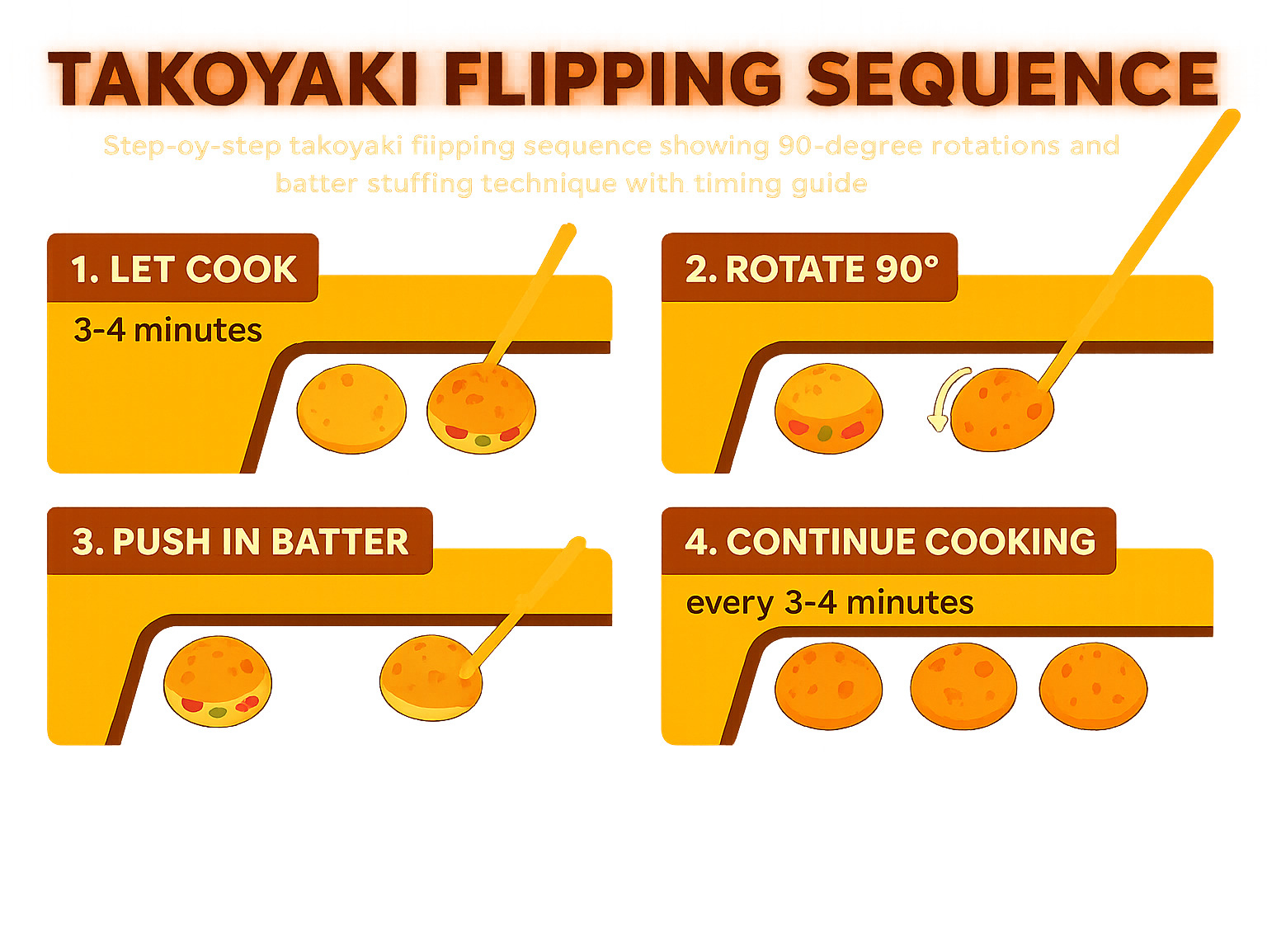
Remember: generous oil and patient turning create perfect spheres. Each ball needs at least four rotations during cooking.
Pro Tips & Common Mistakes
Even experienced cooks struggle with takoyaki at first. These insider secrets separate amateur attempts from professional results that would make Osaka street vendors proud.
Oil is your best friend. The biggest mistake home cooks make? Being stingy with oil. You should see about 5mm pooled in each mold – this creates the crispy exterior that contrasts beautifully with gooey centers.
Overfill those molds. It sounds wrong, but slightly overfilling each cavity creates better balls. As you rotate, excess batter gets pushed into the forming sphere, creating perfectly round shapes without gaps or flat spots.
Master the timing. Your first flip happens when bottoms and edges set but tops stay wet – usually 3-4 minutes on proper heat. Flip too early and balls fall apart; too late and they become tough and chewy.
Perfect the stuffing technique. After each 90-degree rotation, use your skewer to push loose batter into the forming ball. This motion eliminates air pockets and creates that signature molten center everyone craves.
Watch out for these common failures: sticking (not enough oil), flat balls (underfilling or poor turning), tough texture (overmixed batter or excessive heat), raw centers (impatience), and uneven browning (poor heat management).
| Feature | Cast-Iron | Electric |
|---|---|---|
| Heat retention | Excellent | Good |
| Temperature control | Manual | Automatic |
| Flavor development | Superior | Standard |
| Ease of use | Challenging | Beginner-friendly |
| Price range | $25-60 | $45-190 |
| Maintenance | High | Low |
Beyond Tradition: Variations, Dietary Options & Where to Eat
The beauty of takoyaki lies not just in its traditional form, but in how it adapts to different tastes and dietary needs around the world. While purists might raise an eyebrow, these creative variations have introduced countless people to the joy of crispy-outside, gooey-inside perfection.
In modern Japan, you’ll find mentaiko takoyaki bringing spicy cod roe heat to the classic recipe, while cheese-corn combinations have won over younger generations who love that extra creamy richness. Some adventurous Osaka shops serve negi-toro versions with minced tuna and green onion – it’s like sushi meets street food in the most delicious way possible.
The international fusion scene has produced some surprisingly tasty results. We’ve seen truffle-parmesan takoyaki at upscale Japanese restaurants that somehow work beautifully, and jalapeño-cheese versions from food trucks that bring just the right amount of heat.
What’s fascinating is how different regions within Japan tell their own takoyaki stories. Taiwanese squid balls follow similar techniques but use local squid and often pack more spice, while some Japanese regions add cabbage to their batter or incorporate whatever fresh seafood is available locally.
For those serious about exploring authentic and modern interpretations, our Best Food Destinations guide showcases places where traditional takoyaki meets creative innovation.
Regional & International Twists
Osaka’s Dotonbori district remains the holy grail of takoyaki culture, with hundreds of shops each claiming the best recipe in town. Aizuya, the original 1930s shop, still serves traditional versions alongside newer establishments experimenting with premium ingredients like wagyu beef or seasonal truffle oil.
Akashiyaki from nearby Kobe deserves special recognition as takoyaki’s sophisticated older sibling. These delicate balls use more egg and less flour, creating an almost custard-like texture that’s served with light dashi broth for dipping instead of heavy sauce.
Taiwan’s long relationship with Japanese cuisine has birthed its own squid ball tradition that follows takoyaki techniques but incorporates local flavors like pickled mustard greens and different spice profiles. The result is familiar yet distinctly Taiwanese.
Western adaptations range from respectful homages to wild experiments. The most successful ones understand that takoyaki’s magic lies in that textural contrast – the crispy shell giving way to molten goodness inside.
Dietary Adaptations for Everyone
Vegetarian takoyaki has become a revelation, with mushroom varieties leading the charge. Shiitake, oyster, and king oyster mushrooms provide that crucial umami depth and surprisingly octopus-like chewiness. Some recipes combine multiple mushroom types with kombu seaweed for extra oceanic flavor.
Vegan versions require more creativity but are totally doable. Plant-based mayonnaise handles the topping situation, while aquafaba (that magical chickpea liquid) can replace eggs in the batter. The texture changes slightly, becoming a bit more delicate, but it’s still absolutely delicious.
Gluten-free adaptations work beautifully with rice flour or specialized gluten-free blends. The result is less chewy and more delicate than traditional versions, but some people actually prefer this lighter texture.
Beyond octopus, successful protein alternatives include shrimp or crab for seafood lovers, chicken or pork for meat preferences, and tofu or tempeh for plant-based protein. Cheese versions have become incredibly popular with vegetarians.
Where to Satisfy Your Takoyaki Craving
In Japan, takoyaki is everywhere – from yatai street stalls that provide the full theatrical experience to convenience stores offering 24/7 availability. Izakaya (casual pubs) serve them as perfect drinking snacks, while specialized takoyaki shops lift the dish to an art form.
The international scene has exploded in recent years. Major cities with Japanese communities often have authentic takoyaki shops tucked away in food halls or Japanese districts. In New York City, several restaurants and food halls serve fresh versions, though finding truly authentic ones requires some detective work.
Home cooking remains the most accessible option for most people. Online retailers sell takoyaki pans and authentic ingredients, while video tutorials like this comprehensive takoyaki recipe provide visual guidance that makes the flipping technique much easier to master.
Frozen options from Asian supermarkets provide decent alternatives when fresh isn’t available. They’re not quite the same as fresh, but they definitely satisfy cravings and work great for introducing newcomers to the flavors.
Food festivals and pop-ups often feature takoyaki vendors, especially during summer months. These events provide perfect opportunities to try authentic versions without booking a trip to Japan.
For those wanting the full cultural experience alongside their takoyaki, our Guided Food Tours showcase how this beloved street food fits into Japan’s broader culinary landscape.
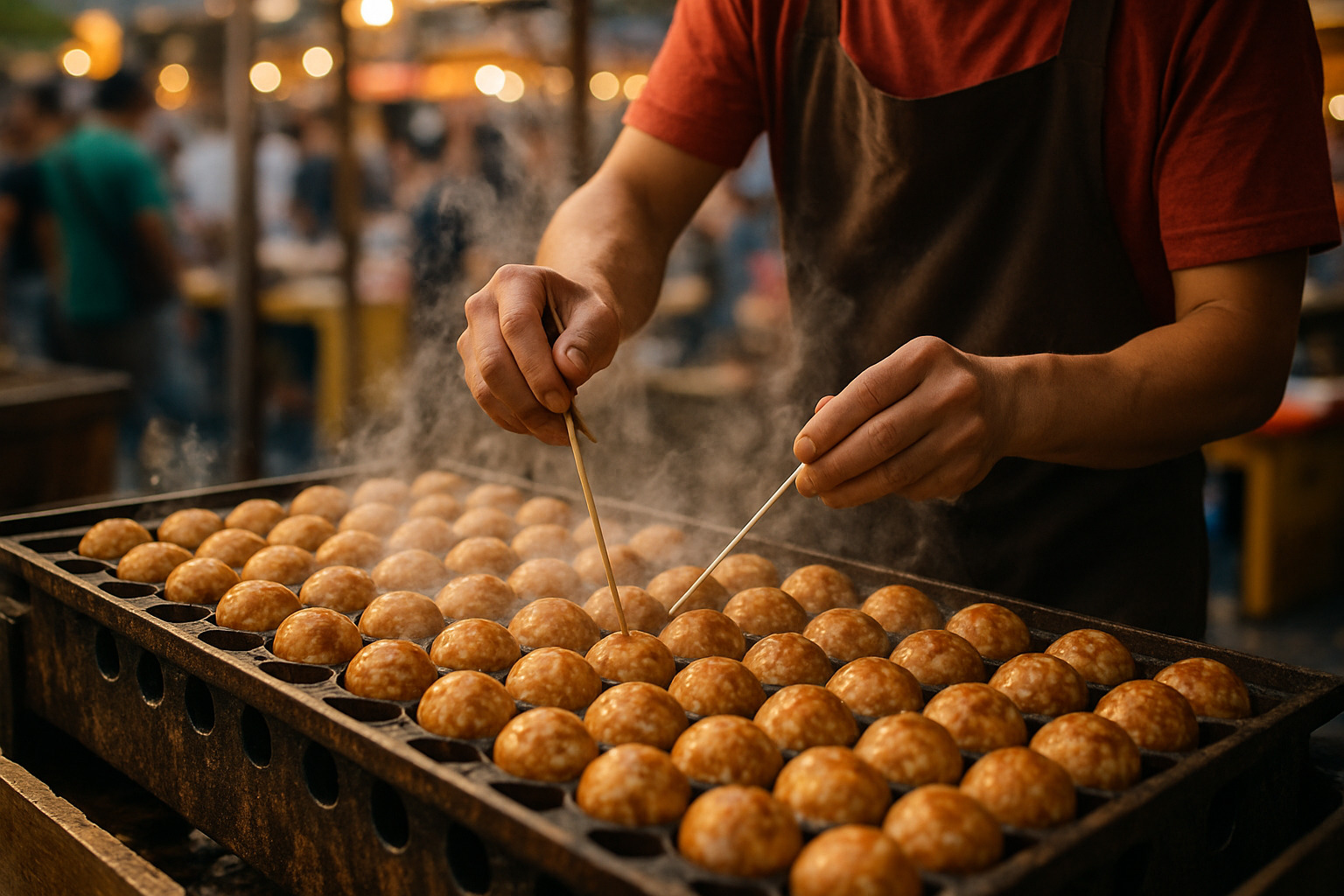
Frequently Asked Questions about Takoyaki
What does authentic takoyaki taste like?
The first bite of authentic takoyaki is like a flavor explosion in your mouth. You’ll experience that satisfying crunch as your teeth break through the golden, slightly crispy exterior – and then comes the magic. The interior is warm, creamy, and almost molten, with a texture that’s somewhere between custard and thick soup.
The taste itself is deeply umami-rich, thanks to the dashi-infused batter that forms the foundation. Think of it as a savory, oceanic flavor that’s both comforting and complex. The octopus pieces add a pleasant chewiness and mild seafood taste that never feels overwhelming or “fishy.”
But the real flavor symphony comes from the toppings. The takoyaki sauce brings sweet and tangy notes reminiscent of a Japanese-style barbecue sauce, while the creamy mayonnaise adds richness and a subtle tang. The aonori (seaweed flakes) contribute an earthy, oceanic flavor, and those dancing katsuobushi (bonito flakes) provide a smoky depth that ties everything together.
What makes takoyaki so addictive is this perfect balance of textures and flavors – crispy meets creamy, sweet meets savory, and that wonderful smokiness from the bonito flakes lingers on your palate long after the last bite.
Can I make takoyaki without octopus or a special pan?
Don’t worry if you can’t find octopus or don’t own a takoyaki pan – you can absolutely still enjoy this incredible snack! Many creative home cooks have found delicious alternatives that capture the essence of authentic takoyaki.
For octopus substitutes, the possibilities are surprisingly endless. Shrimp works beautifully and provides a similar seafood flavor with a slightly different texture. Mushrooms (especially shiitake or king oyster) offer that satisfying chewiness and umami depth that vegetarians love. Cheese cubes create an indulgent, gooey center that’s become popular even in Japan. Cooked chicken, bacon bits, or even crab meat all make excellent fillings.
The key is cutting your chosen filling into small, uniform pieces – about 1cm cubes work best so they don’t overwhelm the delicate batter.
As for equipment alternatives, Danish ebelskiver pans are your best friend. They create slightly larger balls but use the exact same flipping technique. Some adventurous cooks have even used cake pop makers with success, though you’ll need to adjust the timing since they cook faster.
If you don’t have any specialized equipment, try making “takoyaki pancakes” in a regular frying pan. Pour the batter, add your fillings to one half, fold it over like an omelet, and cut into bite-sized pieces. You’ll get similar flavors with a different but equally delicious texture.
Is takoyaki healthy and how many calories per serving?
Takoyaki falls into that sweet spot of being a reasonably healthy snack when enjoyed in moderation. A typical serving of 4 takoyaki balls contains about 159 calories, which is quite reasonable for such a satisfying treat.
What makes takoyaki nutritionally interesting is its protein content – you’ll get nearly 10 grams of high-quality protein from those 4 balls, thanks mainly to the octopus and eggs in the batter. The octopus also provides essential amino acids and minerals like iron and vitamin B12.
The sodium content sits at around 373mg per serving, which represents about 16% of your daily recommended intake. This comes mainly from the dashi stock, soy sauce, and those flavorful toppings. If you’re watching your sodium intake, you might want to go easy on the sauce or make your own lower-sodium version at home.
The cooking method is actually quite healthy compared to many street foods. Takoyaki is pan-fried rather than deep-fried, using much less oil than foods like tempura or fried chicken. The generous oil used in cooking creates that crispy exterior but most of it stays in the pan.
For a healthier approach, try adding finely chopped vegetables like cabbage or carrots to your batter for extra fiber and nutrients. You can also control portion sizes easily – takoyaki is rich and satisfying, so a small serving often hits the spot perfectly.
The bottom line? Takoyaki is a treat that you can feel good about enjoying regularly, especially when you make it at home and control the ingredients.
Conclusion
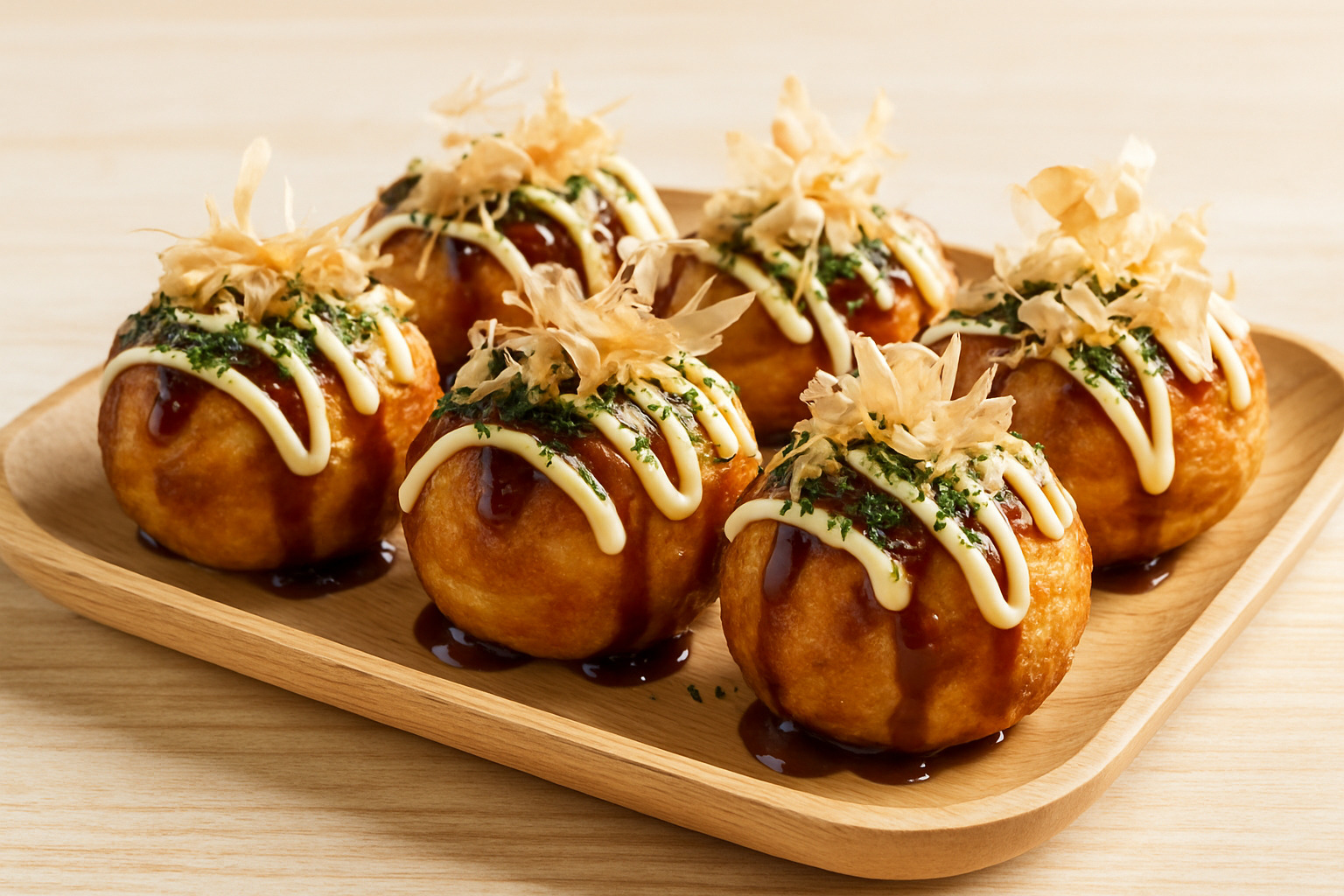
There’s something magical about watching those golden takoyaki balls sizzle in their cast-iron molds, the bonito flakes dancing from the heat as they’re served piping hot. This isn’t just street food – it’s edible theater that tells the story of Osaka’s vibrant food culture and Japan’s genius for turning simple ingredients into extraordinary experiences.
From Tomekichi Endo’s innovative creation in 1935 to today’s global phenomenon, takoyaki has proven that the best comfort foods are those that bring people together. Whether you’re navigating the busy streets of Dotonbori or gathering friends around your kitchen table with a new takoyaki pan, these crispy-gooey spheres create moments of pure joy.
The beauty of takoyaki lies in its perfect imperfection. Your first batch might be lopsided or stick to the pan, but that’s part of the journey. Each attempt teaches you something new about heat control, timing, or the art of the 90-degree flip. Soon enough, you’ll develop your own rhythm and maybe even your own creative variations.
What makes takoyaki truly special is how it bridges tradition and innovation. You can honor the classic octopus-filled original while exploring cheese-corn fusion or mushroom alternatives for vegetarian friends. The technique remains the same, but the possibilities are endless.
We’ve covered everything from the essential dashi-infused batter to the theatrical toppings that make each serving Instagram-worthy. You now understand why generous oil application matters, how to achieve that coveted molten center, and where to find authentic experiences around the world.
Ready to start on your own culinary trip? The Dining Destination is here to guide you through the world’s most exciting food experiences. From street food findies to fine dining innovations, we help passionate food lovers like you find their next great meal.
Start planning your delicious journey with our Best Food Destinations guide – because the best travel stories always begin with great food.

